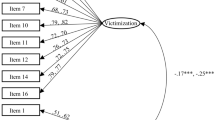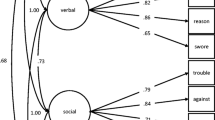Abstract
This study evaluated the psychometric properties of the Social Experience Questionnaire (SEQ) in a sample of 1158 adolescents aged 13–17 years. Confirmatory factor analysis fit indices supported the hypothesized three-factor model of the SEQ that assesses overt and relational victimization, and prosocial behaviors from peers. Analyses of gender differences revealed that boys reported being overtly victimized more than girls, and girls reported greater receipt of prosocial behaviors from peers than boys. No gender differences in relational victimization were found. The internal consistency was adequate across gender, and test–retest stability over 12 months was modest. Intercorrelations among overt and relational victimization subscales suggest that these subscales assess related, but relatively independent constructs of peer victimization. These findings support the use of the SEQ with adolescents.
Similar content being viewed by others
References
DS Hawker MJ Boulton (2000) ArticleTitleTwenty years’ research on peer victimization and psychosocial adjustment: a meta-analytic review of cross-sectional studies J Child Psychol Psychiatry 41 441–455 Occurrence Handle10.1017/S0021963099005545 Occurrence Handle10836674
EA Storch C Masia-Warner MR Brassard (2003) ArticleTitleThe relationship of peer victimization to social anxiety and loneliness in adolescence Child Stud J 33 1–18
NR Crick JK Grotpeter (1996) ArticleTitleChildren’s treatment by peers: victims of relational and overt aggression Develop Psychopath 8 367–380
EA Storch MK Nock C Masia-Warner ME Barlas (2003) ArticleTitlePeer victimization and social-psychological adjustment in Hispanic-American and African-American children J Child Fam Stud 12 439–452 Occurrence Handle10.1023/A:1026016124091
EA Storch CL Masia-Warner (2004) ArticleTitleThe relationship of peer victimization to social anxiety and loneliness in adolescent females J Adolesc 27 351–362 Occurrence Handle10.1016/j.adolescence.2004.03.003 Occurrence Handle15159093
NR Crick MA Bigbee (1998) ArticleTitleRelational and overt forms of peer victimization: a multi-informant approach J Consult Clin Psychol 66 337–347 Occurrence Handle10.1037/0022-006X.66.2.337 Occurrence Handle9583337
MJ Prinstein J Boergers EM Vernberg (2001) ArticleTitleOvert and relational aggression in adolescents: Social-psychological adjustment of aggressors and victims J Clin Child Psychol 30 479–491 Occurrence Handle10.1207/S15374424JCCP3004_05 Occurrence Handle11708236
L Bond JB Carlin L Thomas K Rubin G Patton (2001) ArticleTitleDoes bullying cause emotional problems? A prospective study of young teenagers BMJ 323 480–484 Occurrence Handle10.1136/bmj.323.7311.480 Occurrence Handle11532838
Storch EA, Masia-Warner C, Dent HC, Klein RG : Peer victimization and social anxiety in adolescence: A prospective study. Agg Beh, in press.
EA Storch E Zelman M Sweeney G Danner S Dove (2002) ArticleTitleOvert and relational victimization, and psychosocial adjustment in minority preadolescents Child Stud J 32 73–80
EA Storch L Esposito (2003) ArticleTitlePeer victimization and posttraumatic stress in children Child Study J 33 91–98
L Cronbach (1951) ArticleTitleCoefficient alpha and the internal consistency of tests Psychometrika 16 297–334
PE Shrout JL Fleiss (1979) ArticleTitleIntraclass correlations: Uses in assessing rater reliability Psychol Bull 86 420–428 Occurrence Handle10.1037//0033-2909.86.2.420
JL Arbuckle (1996) AMOS user’s guide, Version 3.6 Smallwaters Chicago
JF Hair RE Anderson WC TathamRL Black (1992) Multivariate data analysis with readings MacMillan New York
B Thompson (2004) Exploratory and confirmatory factor analysis: Understanding concepts and applications American Psychological Association Washington DC
BM Bryne (2001) Structural equation modeling with AMOS: Basic concepts, applications, and programming L Erlbaum Associates Mahwah, NJ
DL Streiner (2003) ArticleTitleBeing inconsistent about consistency: When coefficient alpha does and doesn’t matter J Per Assess 80 217–222 Occurrence Handle10.1207/S15327752JPA8003_01
CC Strauss CL Frame R Forehand (1987) ArticleTitlePsychosocial impairment associated with anxiety in children J Clin Child Psychol 16 235–240
Author information
Authors and Affiliations
Corresponding author
Rights and permissions
About this article
Cite this article
Storch, E.A., Crisp, H., Roberti, J.W. et al. Psychometric Evaluation of the Social Experience Questionnaire in Adolescents: Descriptive Data, Reliability, and Factorial Validity. Child Psychiatry Hum Dev 36, 167–176 (2005). https://doi.org/10.1007/s10578-005-3495-z
Issue Date:
DOI: https://doi.org/10.1007/s10578-005-3495-z




